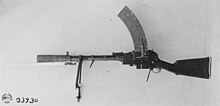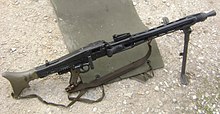Squad automatic weapon
This article needs additional citations for verification. (May 2021) |

A squad automatic weapon (SAW), also known as a section automatic weapon or light support weapon (LSW), is a man-portable
Squad automatic weapons usually fire the same
Overview

One of the first weapons used in this role was the Madsen machine gun. Although limited in today's terms, the Madsen was introduced in an era when the standard infantry rifle was a bolt-action repeater with fixed magazines reloaded with single rounds or chargers; sustained rapid fire with these weapons could be maintained only for very short periods of time. The Madsen was capable of fully automatic fire; despite having only limited magazine capacity, this was still more than that of the infantry rifle, and it was of the quick change detachable box magazine type. Though over 100 years old, the Madsen is still in limited use today. The standard machine guns of this era were of the Maxim type. Used by the British, Germans, and the Russians, these weapons were bulky, heavy, tripod-based, and water-cooled, they required a team of four men and, although excellent in the defence, were not suited to manoeuvre warfare.

Another pioneering weapon in this role was the Browning Automatic Rifle (BAR). Introduced late in World War I, it remained in front-line service into the Vietnam War. Intended originally as an automatic rifle capable of delivering suppressing "walking fire" in the advance, the BAR came to be used in the light machine gun role. During World War II, as the importance of having a source of mobile automatic fire increased, the number of BARs in a unit also increased, until in some units it represented 1 in 4 of the weapons present in a squad. During its long service in the US military, it was pivotal in the evolution of U.S. fireteam tactics and doctrine that continues to the present day.

Modern squad automatic weapons (such as the RPK and L86) are modified assault rifles or battle rifles (e.g. FN FAL 50.41 and M14A1) that may have increased ammunition capacity and heavier barrels to withstand continued fire and will almost always have a bipod. In the case of some assault rifles, such as the H&K G36 or Steyr AUG, the SAW is simply the standard rifle with a few parts replaced. However, the Austrian Army, though issuing the Steyr AUG rifle, does not issue the HBAR (heavy barrel) variant. Instead, the 7.62mm caliber MG74, a derivative of WW2-era German MG 42, is issued.
National examples
Belgium

China

The People's Liberation Army initially used the Type 56 LMG as the primary light machine gun to replace all of its obsolete WW2 LMGs. After the Sino-Vietnamese War, the PLA adopted the drum-fed Type 81 LMG for high mobility, which was later replaced by QJB-95 since the adoption of QBZ-95. However, the PLA changed back to belt-fed QJB-201 light machine guns since 2021.
Germany

West Germany's original plan in the late 1980s was to adopt the new 5.56mm
Italy
In the 1980s the Italian military considered the idea of adopting a heavy-barrelled magazine-fed 5.56mm automatic rifle. It was to accompany the 5.56mm
Netherlands
The
Soviet Union/Russian Federation
The Russian support weapon concept was designed around providing
- RPK
- RPKS: A version with a side-folding wooden stock (S for -skladnoi).
- RPK-74: A version chambered for the new 5.45x39mm cartridge.
- RPK-74M: An improved version (M for modernizirovanniy) of the RPK-74 with polymer furniture.
- RPK-201: An export model of the RPK-74M chambered in 5.56x45mm NATO.
- RPK-203: An export model of the RPK-74M chambered in 7.62x39mm.
- RPL-20: The belt-fed LMG designed to fill the gap between RPK and PK machine gun.
United Kingdom

The
United States

In United States usage, the M249 light machine gun is commonly referred to as the Squad Automatic Weapon (SAW).[2][3]
In the 1970s the United States began realizing that it might have to fight a conflict in the deserts and mountains of the Middle East or Near East rather than the jungles of Asia or forests of Europe and Eurasia. The Squad Automatic Weapon program was designed to create an intermediate weapon between the M16 rifle and
The
In 2019, US Army launched
- Sig Sauer MG-6.8 with 6.8 Sig hybrid round, declared winner of the program as the XM250
- General Dynamics RM277-AR with .277 TVCM polymer cased round manufactured by True Velocity
- AAI and Textron AR with 6.8mm CT cased telescoped round manufactured by Olin Winchester
See also
References
- ^ "TASS: Military & Defense - Kalashnikov signs contract to supply Defense Ministry with newest RPK-16 machine guns". 2018-02-08. Archived from the original on 8 February 2018. Retrieved 2022-04-18.
- ^ Boe, David (August 1, 1997). "Mission Continues" (PDF). The Talon. Vol. 3, no. 31. Eagle Base, Tuzla, Bosnia-Herzegovina: 1st Infantry Division (Task Force Eagle) Public Affairs Office. p. 6. Archived from the original (PDF) on August 15, 2000. Retrieved November 27, 2013.
Sitting atop the platoon leader's HMMWV, the 20-year-old soldier mans a Squad Assault Weapon and monitors traffic at the crossroads.
- ISBN 978-1-4402-2652-6. Retrieved November 27, 2013.
When it comes to machine guns, FNH USA is turning out copies of the M249 Squad Assault Weapon (SAW) that has been in the US military inventory for several decades.
